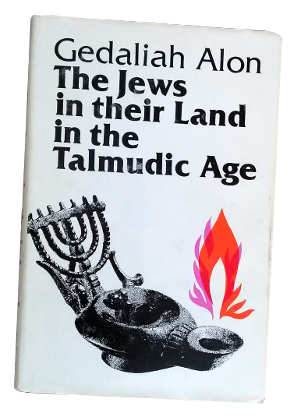Book Review: The Jews in their Land in the Talmudic Age by Gadaliah Alon.
A magnificent piece of scholarly work that touches on life in Israel from 70 to 640 A.D.
His retelling of the story of Middle-East mankind during this period draws from classical Greek, Roman, Patristic, and Rabbinic sources that is simply astounding. He combines religion, culture, language, economic systems, leadership structures both in the Jewish community and in context of Roman occupation, historical analysis, and social perspectives into an intelligent and cohesive narrative. He especially excels covering the change in religious, social and leadership structures after the destruction of the Temple, and the traditions that underlies the development and establishment of the Mishnah and Talmud.
The work is ascribed to Gedaliah Alon, who is an enigma. There are no photos in any popular biography of him, and those bios are normally only a paragraph long. He never wrote a book, but yet there is one. In Israel, where he was a teacher at the Hebrew University, there is a street in Jerusalem named after him, but this is a quiet reminder. He was the first recipient of the Israel Prize, the highest honor given by the State of Israel for excellence, but this only extends to the modern Israeli conscience, not to the English speaking world. His name was never echoed in the halls of the Hebrew University while I was there, nor were there any statues or busts found. He was married to a Mina Alon, and had at least one child, Nahi Alon, who is a clinical psychologist, but the information is sparse.
It was chance that I picked up the book at the Hebrew University’s Akademon book store back in the 1980s. The cover looked interesting and thought it would be worth the risk. It was packed in my to be looked at later file, which took a couple of years to turn the cover. Ever since that first page was turned, it changed my approach to historical critique. This unknown man has had a deep influence on my own approach to the narratives that surround the Christian narrative.
This book is a must-read for anyone trying to develop an idea of how the Middle East world operated during this period, especially for Jews living in the land of Israel.
Alon suddenly died of a heart attack at 49 years of age back in 1950. Admirers of Alon who were deeply impressed by his teachings, collated the many monographs that he previously published, and combined them with his lecture notes to make a posthumous book dedicated to him. Shmuel Safrai, one of his students and later a professor at the Hebrew University, was instrumental in the process. The book was originally written in modern Hebrew, but later translated by Gershon Levi into English, and so the The Jews in their Land in the Talmudic Age was born.
His story begins in Russian controlled Kobryn, Belarus, where he excelled in his Talmudic studies, and then went to the Unversity of Berlin for a year, which likely broadened his mind to other disciplines outside of Judaism. He then immigrated to Israel and completed his studies at the Hebrew University, and remained there as a teacher for the rest of his life. The foreward in his book claims that he refined the system of interpretation set out by Adolf Büchler1 an “Austro – Hungarian rabbi, historian and theologian” who wrote distinguished works on the Jews during the Second Temple period. 2
He was a historical chronographer, not a theologian by any means, though he does greatly draw from these resources to add to his narrative, they are rarely central to any of his themes. This is what sets him apart, and likely makes him so indistinguished. He appeals neither to the practicing Jew, nor to the ardent Christian, or to those uninterested in religion. This makes his audience quite small, but to those who are looking for coverage of this period from a comprehensive historical literature perspective, this is a veritable gold mine.
The eminent teacher has not escaped criticism. Doron Mendels, a present full-time professor at the Hebrew University, claims that Alon reflected the age that he lived in. Mendels claims that Alon’s background of Orthodox to enlightened Jew, and then European nationalist reflected a writing that wished to redefine Judaism both in historic and modern terms – a “fragmetized type of memory”,3 and another recent book, Judaism and Crisis: Crisis as a Catalyst in Jewish Cultural History, states that Alon wrote with Zionistic sympathies.4
The greatest drawback to Alon is price. The work was originally published in Jerusalem by Magnes Press, which the picture above is from. It was two volumes and has long been out-of-print by them. Harvard University Press has reprinted a paperback version, combining both original volumes into one for under $65.00 US. It may be in your local library, but it is one of those books that you want to keep near your desk. It is a handy resource.
- Pg. IX
- http://www.jewishencyclopedia.com/articles/3787-buchler-adolf
- Doron Mendels. Memory in Jewish, Pagan and Christian Societies of the Graeco-Roman World, New York: T & T Clark International. 2004. Pg. 131
- Armin Lange, K. F. Diethard Romheld, Matthias Weigold. Judaism and Crisis: Crisis as a Catalyst in Jewish Cultural History. Schriften des Institutum Judaicum Delitzschianum. Vol. 9. Vandehoek & Ruprecht. 2011. Pg. 189
